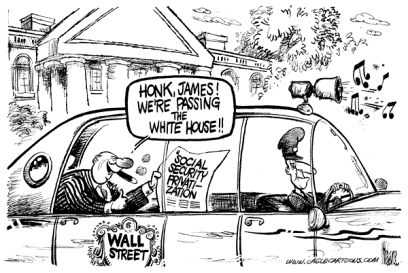|
|
Wall St Could Make a Social Security Killing
By Stephen Ellis, The Australian
December 28, 2004

IT'S not often even the best-connected and most powerful industry encounters a group of equally powerful politicians desperate to put $US1 trillion ($1.3 trillion) in its collective pocket.
So it is unsurprising Wall Street has so far been silent on the Bush administration's post-election push for social security reform, including redirection of a share of new contributions to private retirement accounts.
Although most financial leaders support the idea and industry groups (plus armies of lobbyists) are working behind the scenes in Washington to make a case for private accounts, no CEO of a major financial firm is likely to go public soon.
That's because Wall Street has learnt from the past two times the idea of legislating trillions of dollars into its hands came up, in the late 1990s and again in 2001.
Both times private accounts were advocated as a means of repairing social security - the politically sacred but creaky pay-as-you-go retirement scheme projected to run into increasing financial trouble over the next 50 years as the US's population ages.
And both times the financial sector came out as a vociferous supporter, only to be accused by opponents of having little interest in reform of social security, and (gasp)
simply wanting to line its pockets with management fees.
Supporters say laws channelling funds into private accounts owning high-yield assets (such as equities) will lift overall returns on US retirement savings. In the late 1990s, some enthusiasts said private accounts combined with "New Economy" equity returns could solve the whole damned problem.
But there is fairly widespread agreement among economists that gains from such proposals (after accounting for transaction costs) are insignificant compared to the gap between social security entitlements and contributions looming in most projections.
High-return assets are also usually high-risk assets - creating a separate set of political and regulatory problems around fairness, variances in returns and moral hazard.
As a result, everyone from Reserve Bank chairman Alan Greenspan to two members of President George W. Bush's economics team has warned that private accounts, as envisaged so far, are no free lunch and do little to raise US retirement saving - the underlying problem.
On the other hand, some economists feel the scurrilous suggestion that the Wall Street firms are simply interested in lining their pockets may have some basis. They argue that diversion of social security contributions into private accounts could generate a colossal windfall.
One of the most prominent critics of the concept, University of Chicago economist Austan Goolsbee, estimates the net present value of management fees that Wall Street would collect over the next 75 years from partial privatisation of social security as somewhere between $US424 billion and $US1.1 trillion.
That compares with a net present value of about $US3.3 trillion for the projected fees Wall Street firms will generate from all other activities over the same period. We're talking real money.
This week, the Securities Industry Association hit back with its own projections, showing a net present value for fees of as little as $US39 billion. That, on the other hand, is loose change by the standards of the Street and the Feds.
Goolsbee's estimates assume annual management fees on private accounts of at least 0.3 per cent of assets, and more likely 0.8 per cent. His numbers are based on a modest privatisation scheme put forward by the Bush-appointed 2001 Commission to Save Social Security.
In countering, the SIA instead assumed holders of private accounts would be limited to investing in simple low-risk funds with annual management fees of only 0.1 per cent.
The average management fee across all US mutual and pension funds is currently 1.1 per cent. But this includes high fees on exotic investment options that not even diehard libertarian Republicans advocate as a good place to put social security contributions.
Until a social security reform plan appears that has some chance of getting through Congress (which may not happen at all if it depends too heavily on even more federal borrowing), the debate will remain heatedly imprecise. But there are precedents - some close to home - that suggest Wall Street stands to do very well indeed if reform mandates a flow of cash into private accounts, whatever its spokesmen may say.
The Hawke Government's introduction of award-based superannuation in 1986 and the superannuation guarantee in 1992 created a bonanza for financial firms. Australian superannuation assets rose from about $60 billion in 1986 to $470 billion today, with managers collecting annual fees on almost all of it.
|
|




